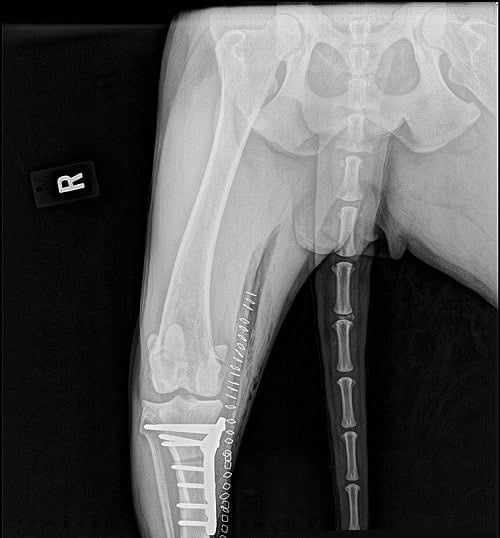What is an ACL or cranial cruciate ligament?
The cranial cruciate ligament (also known as the anterior cruciate ligament or ACL) is the most important ligament in the knee for keeping the joint stable. It’s primary job is to prevent forward/backward motion of the femur and tibia, the two opposing bones of the joint. When this ligament tears or ruptures, even partially, those two bones slide back and forth on each other, known as “drawer motion”. This motion and instability causes inflammation of the joint, and is quite painful to the animal. If the joint is not stabilized, arthritis can develop over time, and long term lameness can result.
How can an ACL tear be repaired?
At Edmonton West Animal Hospital, we offer different surgical cruciate repair techniques.
- TPLO surgery (tibial plateau leveling osteotomy) is an orthopedic procedure in which the slope of the top of the tibia is reduced. The top (proximal end) of the tibia is cut with a rounded saw blade, rotated a specific distance, and plated back together using a specialized bone plate and screws. This rotation decreases the slope of the joint (the angle of the tibial plateau), and as it heals, the joint becomes stable again.
- Extra-capsular techniques include several techniques that employ a synthetic “mimic” of the cranial cruciate ligament. Each technique is slightly different, but all involve a surgical implant being inserted beside or around the joint to stabilize the two bones of the knee and minimize the “drawer motion”.
Which cruciate repair technique is right for my dog? What does TPLO cost? What is the TPLO success rate?
Our orthopedic surgeon will be able to meet with you and your dog, and determine which repair is best. During the surgical consultation, he will examine your dog, review his/her history with you, and explain the different types of surgery available; he can advise you and your family on the pros and cons of each technique, as well as the success rate for the different procedures. He will also give you cost estimates for the different techniques. Please give our clinic a call at (780) 488-0124 to book an appointment with Dr. Gosal for a cruciate repair consultation.
What does the post-op care involve? How will my dog recover from TPLO surgery?
Your dog will be hospitalized overnight, on IV fluids and pain medications to allow him/her to rest for the first night following surgery. Generally most orthopedic patients are set to go home the following day, and are sent home on oral pain medication, antibiotics, and sometimes mild sedatives. Once at home, you will need to keep your dog strictly confined for the first few days following surgery; TPLO recovery takes time and patience. Over the next few weeks and months, there are physiotherapy and exercises you can perform to help restore your pet’s function and mobility. Adequate rest and dedicated physiotherapy are the two more important aspects to a successful recovery. Please check out our TPLO home care page for more detailed information.
Will my dog be in pain after the surgery?
It is our goal to ensure, with every orthopedic surgery, that each pet has adequate pain control before, during, and after surgery. Your dog will receive a sedative containing an opioid pain medication before anesthesia, and once under anesthetic, most patients will then receive an epidural which generally lasts 6-8 hours. We maintain each patient on IV fluids during and after the surgery into which we add additional pain medication to keep them comfortable post-op and throughout the night. Each patient will go home with oral medications as well to keep them calm and quiet during their recovery time. Antibiotics, two types of pain medications, and often mild sedatives are sent home with your dog. All of these medications work in conjunction with each other, and can be given at the same time. Please continue all prescriptions as prescribed, even if your dog “seems fine” and you think s/he doesn’t need them. Sometimes your dog will vocalize once they are home, but this is a common side effect of the anesthesia itself; it can take 24 hours or more for the anesthetic drugs to wear off. If your dog continues to be agitated, vocalize, or otherwise not himself/herself after the first 48 hours have passed, please give our clinic a call.
How do I know if my dog is in pain?
Every dog shows pain differently. Sometimes it is as straightforward as vocalizing or flinching when touched; it can be as subtle as a decrease in appetite, increased heart rate and respiration rate, withdrawing from family members, hunched posture, or reluctance to move. Your dog will be sent home with pain medication, however if you suspect that the medication isn’t sufficient, please give our clinic a call.
What about my dog’s bandage and stitches?
We send our TPLO and ACL repair patients home with a bandage on the leg for the first 2 days to protect the incision while the skin seals. This bandage will need to be removed 2 days after your bring your dog home, and you can do this at home. There is often a sticky elastoplast layer at the top to help hold the bandage up; if you are having difficulties removing this sticky adhesive, you can try applying vegetable or mineral oil to the sticky part to help neutralize the glue. It is generally easiest to remove the bandage while your dog lays on his/her side, with the affected limb facing up. If you are having difficulties or are unsure how to get the bandage off, you can bring your dog back to the clinic and we can help you with the bandage removal. Your dog will also need to come back in 10-14 days to have his/her sutures or staples removed from the skin incision. Please book an appointment with one of our Animal Health Technologists for this.
What if my dog tries to lick his/her incision? Is this bad?
Infection is one of the most common post surgical complications, and it is easily prevented. It is very important that your dog wears a plastic cone (E-collar) to prevent him/her from licking the incision. Even a small amount of licking can introduce bacteria into the surgical incision, which can then infect the skin, or worse, travel into the joint itself. We will send your dog home with a proper fitting cone to wear during the first two weeks of recovery; there are also other commercially available alternatives to the cone such as the “doughnut blow-up collar”. If your dog struggles to maneuver the cone around food and water dishes, you can give him/her a break from it ONLY IF HE/SHE IS UNDER DIRECT SUPERVISION. This cone should stay in place, even during the night, until the sutures are removed. Infection can greatly jeopardize the outcome of the surgery, and can result in additional costs down the road.
My dog seems to have recovered quickly and is ready to play! Can I fast forward the recovery process?
NO! Your dog may look and act like s/he’s feeling better, but his/her bones and tissues require a MINIMUM of 8-12 weeks to develop scar tissue and heal. It is absolutely imperative that you restrict your dog’s activity, and adhere strictly to the exercise guide provided. Activity must be re-introduced gradually, slowly, and progressively, and if your dog ever seems painful after a scheduled increase in activity, go back to the previous step you were at before. If at any point your dog cries out suddenly, stops using the affected leg, or otherwise suddenly regresses, give our clinic a call. Too much activity too soon can be disastrous to the healing process, and in some cases can result in needing a follow-up corrective surgery.
How long will my dog limp on the leg?
Each dog’s recovery process is different and depends on many factors. Generally, most dogs should be putting at least a little bit of weight on the affected leg within 7 days of surgery, even if it is just toe touching to the ground. From then on, your dog should be gradually using the leg more and more, and limping less and less. The healing process can be slowed down or interrupted by doing “too much too fast”; it takes time to rebuild the muscle mass that has been lost. Be patient, and don’t let your dog regulate his/her own activity level; your dog is relying on YOU for a successful surgical outcome.
How do I know if something is wrong? When should I call the vet?
Some signs to watch for once you bring your dog home following surgery:
- Excessive swelling around the incision or down the leg that lasts longer than a week – some swelling is to be expected for the first week post-op. Bruising is also a common occurrence for the first week following surgery.
- Discharge from the incision after the first few days – it is normal for some oozing to occur within the first 3 days after surgery. If this discharge increases, is not clear (pus like), or is bloody, this may be cause for concern.
- Discomfort even while taking pain medications – if the discomfort is enough to cause your dog to vocalize or cry out, your dog may need additional pain medication.
- Failure to progress through the outlined physiotherapy – if at any point during the rehabilitation process your dog’s limp worsens, or doesn’t improve, you may need to bring him/her back for a recheck with the surgeon, just to check in on the progress of healing.
Will there be follow-up appointments?
Yes. There are several follow-ups required for your dog as follows:
- 10-14 days post-op for suture removal
- 8 weeks post-op for an x-ray to assess bone healing progress
- 16 weeks post-op for final instruction before returning your dog to normal function. This may or may not include another x-ray to assess the bone healing.
If you would like to download the PDF, and do not already have AdobeReader® installed on your computer, click HERE to download.
Call for a Free Quote and to Schedule a Consultation Today! 780-488-0124












